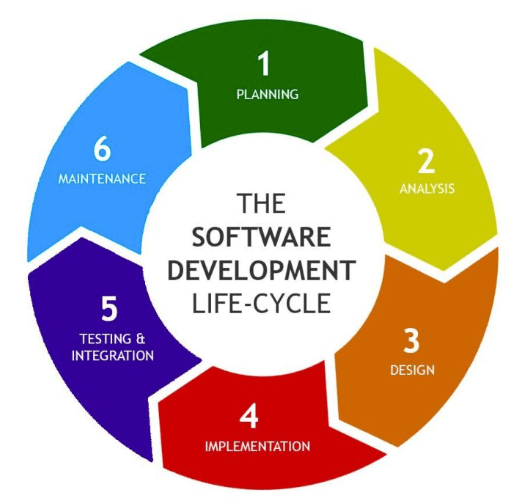What SDLC Stands For & Why It's Important

What SDLC Stands For & Why It's Important
SDLC stands for software development life cycle, a system commonly used in the software development industry. The SDLC consists of five key phases that break the development process into more distinct, smaller functions. Companies should consider implementing the SDLC into engineering and development projects.
The SDLC is a critical component of software development best practices. The framework allows software developers to break down the process of creating a new product.
Additionally, each phase of the SDLC marks opportunities for important cross-team collaboration. This keeps development teams from losing track of essential touchpoints with design, sales, and marketing teammates.
Structuring cross-team collaboration into the phases of the SDLC will ensure that you’re thoughtfully following a process for the most effective end product. This article will detail each step of the SDLC and discuss why it’s vital to employ the framework for your development projects.
What SDLC Stands For?
SDLC stands for software development life cycle. It’s used by professionals working in the software industry to thoughtfully create products by efficiently moving from ideation to design to development.
Industry experts consider the SDLC an optimized process because of its clear phases that guide development efforts and make transitions seamless. The software development life cycle offers a clear path for developers that aids teams in completing projects according to time and cost requirements.
Applying the SDLC will enable your company to approach new development projects with rapidity and certainty.
Software Development Life Cycle Phases
Generally speaking, there are five phases of the software development life cycle and can be broken down into the following phases:
What are the Phases of the Software Development Lifecycle?
- Planning
- Analysis
- Design
- Implementation
- Testing, integration, maintenance
Some development teams opt for up to seven distinct stages, but the structure and follow of the process remain consistent across both versions of the SDLC.

Source: Arkbauer
The SDLC stands to make the software development process more approachable and digestible to companies. Each phase has unique requirements and associated development activities that serve to progress a project.
Planning
The planning stage is the first part of any software development project. This phase includes general ideation and brainstorming activities that will bring the team to a solid understanding of their project.
During the brainstorming phase, development teams must actively put themselves in the client’s shoes. This means that they must get to the root of relevant pain points faced by the client, target audiences, and any additional stakeholders.
Analysis
The analysis stage serves to formalize all of the bright yet loose ideas generated by the planning stage. Here, software development teams and project managers are required to establish and formally outline project requirements.
At this point, your team will have determined pathways to success and solutions to client problems. In this phase, you’ll synthesize these ideas into documentation, including requirements docs, a project timeline, and more.
These resources will help the client conceptualize how the project will progress, but they will also aid your internal team in understanding the scope of the project. This stage is essential to make sure all parties involved stay on the same page throughout the effort.
Design
The design stage is exactly what it sounds like — the team must lay the groundwork for development work by building the foundation for the software.
Teams generally achieve this by defining program architecture and implementing user flows. This stage of the process will undoubtedly involve a team of designers as well as developers. In this period of collaboration, it’s crucial to over-communicate both internally and with the client.
Indeed, your client has ideas of how they want their product to look and feel. While they may not be experienced UX designers, their opinions and feedback will be essential to a smooth and successful collaboration.
Implementation
The implementation phase is also often called the “development” stage. At this point, the architecture, screens, and flows are defined from a design standpoint.
With these resources, the development team is responsible for employing a programming language to build out the backend of the software system. This allows features and functionalities to work as they should come to the launch and final phase of the pipeline.
Testing, Integration, Maintenance
After the development work is complete, it’s time to ensure the final product functions as it should. The testing, integration, and maintenance phase is meant to tie up any loose ends or overlooked errors before launch.
This stage is the last step before some version of a software product launch, so the quality and functionality of the product must be effectively evaluated and examined. When bugs or errors in the code spring up, the team will also correct them at this point.
This stage continues after launch with the maintenance part of the phase. As product issues arise, the team will address them regularly, ensuring the continued quality of the software.
Benefits of the SDLC
The SDLC is known for balancing effectiveness with efficiency, so it’s so crucial to the software development field. In fact, many other tech industries rely on similar life cycle models to ensure the flow and quality of development work.
The SDLC makes the project more efficient by allocating time and resources to different project phases from the beginning. By establishing a project plan and timeline, all parties involved develop an aligned understanding of how the development will occur.
The SDLC offers developers two phases for planning and analyzing the project before design or development even begins. Efficiency, communication, and preparedness are hallmarks of the SDLC system and promote efficiency to those who employ it.
In terms of effectiveness, the SDLC’s structuring helps to ensure quality at every phase of the project. The end of each phase functions as a checkpoint. The development team must confirm that everything is looking and functioning before passing the project to the next phase.
These built-in checkpoints validate the maturity and effectiveness of a product before it progresses to a new stage.
Common SDLC Methodologies
These are some of the most common SDLC models:
- Agile Methodology: Agile is a flexible software development methodology that focus on creating a minimum viable product (MVP) as early on in the software development process as possible. Learn more about How to Maintain Motivated and Agile Development Teams.
- Waterfall Model: The Waterfall Model is known for its linear and sequential nature, with each phase being planned and executed independently. It is commonly used in projects where requirements are well-defined and unlikely to change significantly throughout development. However, it can be less flexible in accommodating changes or feedback once a phase has been completed.
- Kanban Model: a type of Agile development that emphasizes visualizing and managing work in progress. It is based on the principles of lean manufacturing and focuses on continuous delivery and improvement. The Kanban Model provides flexibility and adaptability, making it suitable for projects with dynamic requirements or where changes are frequent. It promotes transparency, collaboration, and continuous learning, enabling teams to deliver value in a more efficient and responsive manner.
- Spiral Model: This SDLC model combines elements of both iterative and waterfall models. When following this model, developers follow each phase in a cyclical manner. Once they reach the testing and evaluation phase, the project can either continue to the next cycle or be terminated if the risks are deemed too high or the objectives cannot be met. If the project continues, it enters a new spiral cycle with an updated plan and refined requirements.
Learn and Understand What SDLC Stands For
SDLC stands for software development lifecycle, one of many lifecycles in the product development and tech industry. Utilizing this cycle and its five phases intentionally will foster a drive for high-quality work while providing a tried-and-true system for staying on time and budget.
